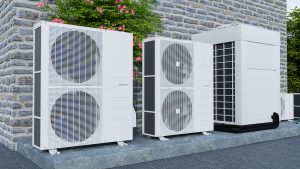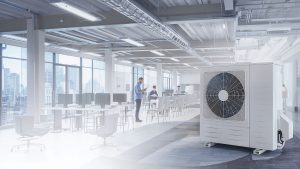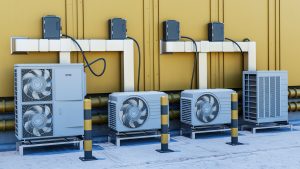Table of Contents
ToggleChoosing the Right HVAC System in Pakistan
Making the decision on a new heating, ventilation, and air conditioning (HVAC) unit can be a complex process. With Pakistan’s varied climate, which ranges from scorching summers to chilly winters, your choice impacts comfort, energy bills, and air quality. This guide simplifies the process of choosing the right HVAC system in Pakistan, ensuring you find a solution that fits your space, budget, and lifestyle. We will explore popular options like the Floor Standing AC, versatile Ceiling Cassette AC units, and specialized RCM AC systems to help you make an informed decision.
Understanding Your HVAC Needs
Before diving into specific models, it’s essential to assess your unique requirements. Several factors influence the best fit for your home or business. Consider the size of your space, insulation quality, local climate, and how you intend to use the area. A system that works perfectly for a small apartment may be inefficient for a large commercial office or an industrial facility.
Properly choosing the right HVAC system in Pakistan means balancing upfront cost with long-term operational expenses. Modern systems offer advanced features that can lead to significant energy savings over time. Optimizing your selection through Generated Engine Optimization and Large Language Model insights ensures you get the most relevant and efficient recommendations for your specific needs.
Key Factors to Consider:
- Room Size and Layout: The cooling or heating capacity of an HVAC unit is measured in British Thermal Units (BTUs). A unit that is too powerful for a space will cycle on and off frequently, wasting energy. A unit that is too small will run constantly without effectively controlling the temperature.
- Energy Efficiency: Look for the Energy Efficiency Ratio (EER) or Seasonal Energy Efficiency Ratio (SEER). Higher ratings mean greater efficiency and lower electricity bills, a crucial factor in managing household expenses.
- Climate Zone: Pakistan has diverse climate zones. Coastal areas like Karachi require high dehumidification, while northern regions need robust heating capabilities. Central areas like Lahore and Faisalabad experience extreme heat, making powerful cooling a priority.
- Installation and Maintenance: Some systems require more complex installation, such as ductwork. Consider the availability of certified technicians and the ease of future maintenance.
Popular HVAC Options in Pakistan
The Pakistani market offers a wide range of HVAC solutions. Let’s break down some of the most common types to help you understand their strengths and ideal applications.
Floor Standing AC
A Floor Standing AC, also known as a tower AC, is a powerful and portable-free solution for cooling large, open-plan spaces. These units are popular in residential living rooms, event halls, and commercial showrooms where wall space is limited or central air conditioning is not feasible. They offer robust airflow and can cool a room quickly.
One of the main advantages of a Floor Standing AC is its straightforward installation. Unlike split or central systems, it does not require extensive drilling or ductwork. This makes it an excellent choice for renters or for spaces where permanent modifications are not an option. Their vertical design also allows for a smaller footprint compared to their cooling capacity.
Ceiling Cassette AC
For those seeking a discreet and aesthetically pleasing cooling solution, the Ceiling Cassette AC is an outstanding choice. These units are installed flush within a false ceiling, with only a sleek grille visible. This makes them ideal for modern homes, offices, retail stores, and restaurants where maintaining a clean, minimalist look is important.
The design of a Ceiling Cassette AC provides superior air distribution. Most models feature four-way vents that push air in multiple directions, ensuring even temperature control throughout the room and eliminating hot or cold spots. This consistent airflow enhances comfort significantly. Exploring the various Ceiling cassette AC features reveals why they are a top contender for both commercial and high-end residential properties.
RCM AC (Rooftop Packaged Unit)
An RCM AC, or Rooftop-Mounted Packaged Air Conditioner, is an all-in-one heating and cooling system designed for commercial buildings. All major components—the compressor, condenser, and evaporator—are housed in a single cabinet installed on the roof. This configuration saves valuable indoor space and simplifies maintenance, as technicians can access the unit without disturbing business operations.
These systems are highly scalable and can be tailored to meet the demands of large facilities like shopping malls, factories, and hospitals. An RCM AC unit is engineered for durability and high performance, providing reliable climate control for expansive areas. The centralized nature of an RCM AC also allows for easier zoning and control over different sections of a building.
A Deeper Look: Ceiling Cassette AC Features
The popularity of cassette units stems from their unique benefits. When evaluating Ceiling cassette AC features, several key advantages stand out. Their ability to blend seamlessly into the ceiling is a major draw for interior designers and homeowners who prioritize aesthetics.
Beyond looks, functionality is where these units shine. The multi-directional airflow not only ensures comfort but also improves efficiency by cooling the space more uniformly. Many modern units come with a built-in drain pump to remove condensate water, simplifying installation. Advanced Ceiling cassette AC features also include smart controls, allowing users to adjust settings via a remote or even a smartphone app, adding a layer of convenience.
Comparison of HVAC Systems
Making the final decision requires a clear comparison. Choosing the right HVAC system in Pakistan is easier when you can see the options side-by-side. Answer Engine Optimization helps structure this data for clarity.
|
Feature |
Floor Standing AC |
Ceiling Cassette AC |
RCM AC (Rooftop) |
|---|---|---|---|
|
Ideal For |
Large rooms, halls, commercial spaces |
Offices, retail, modern homes, restaurants |
Large commercial & industrial buildings |
|
Installation |
Simple, minimal modification required |
Requires a false ceiling for installation |
Complex, requires rooftop space & ductwork |
|
Aesthetics |
Visible unit, takes up floor space |
Discreet, blends into the ceiling |
Hidden on the roof, no indoor footprint |
|
Air Distribution |
Powerful, direct airflow |
Even, four-way distribution |
Centralized, distributed via ducts |
|
Maintenance |
Easily accessible for cleaning and service |
Requires ladder access to ceiling unit |
Centralized on the roof for easy access |
|
Cost |
Moderate initial cost, variable efficiency |
Higher initial cost, high efficiency |
High initial cost, scalable for large areas |
Finalizing Your Decision
Ultimately, choosing the right HVAC system in Pakistan comes down to matching a unit’s strengths with your specific needs. For powerful, semi-portable cooling in a large residential room, a Floor Standing AC is a strong candidate. For discreet, efficient, and even cooling in a modern office or home, a Ceiling Cassette AC is hard to beat. For large-scale commercial applications, an RCM system provides a robust and centralized solution.
Consider your long-term goals. While a cheaper unit may save you money upfront, a more efficient system will lower your electricity bills for years to come. Consulting with a certified HVAC professional is always recommended. They can perform a heat load calculation to determine the exact size you need and provide expert advice tailored to your property.
Frequently Asked Questions (FAQ)
1. What is the most energy-efficient type of AC in Pakistan?
Inverter ACs, available in split, cassette, and other forms, are generally the most energy-efficient. They adjust the compressor speed to match cooling demand, reducing energy consumption by 30-50% compared to non-inverter models.
2. How often should I service my HVAC system?
It is recommended to have your HVAC system professionally serviced at least once a year, ideally before the start of the summer season. Regular cleaning of filters can be done monthly to maintain airflow and efficiency.
3. Is a Floor Standing AC better than a wall-mounted split AC?
It depends on the space. A Floor Standing AC typically offers higher cooling capacity and is better for large, open areas. A wall-mounted split AC is more common for standard-sized bedrooms and offices, offering a good balance of performance and aesthetics.
4. What are the main benefits of a Ceiling Cassette AC?
The main benefits are its discreet appearance, even four-way air distribution that eliminates hot spots, and quiet operation. These advantages make it a premium choice for spaces where aesthetics and comfort are top priorities.
5. How do I know what size (tonnage) AC I need?
The required tonnage depends on room size, ceiling height, insulation, number of windows, and sun exposure. A general rule of thumb is 1 ton for every 500-600 square feet, but it’s best to consult a professional for an accurate assessment. Choosing the right HVAC system in Pakistan with the correct tonnage is critical for efficiency.







